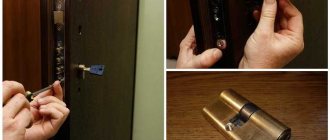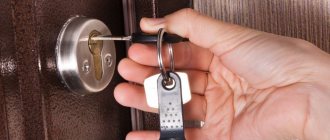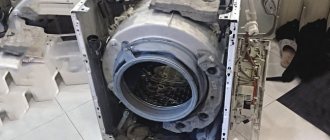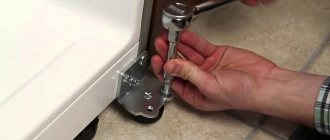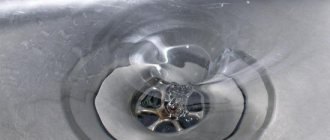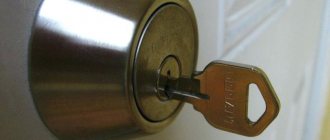When using the front door, problems may arise with the functioning of the locking mechanism. This may be due to either irreversible damage to the element or disruption of its operation due to the lack of proper prevention. If the front door lock jams, not in all cases you need to turn to professionals, since most problems can be solved at home.
Entrance door lock
Causes of jamming
Lock repair may be required for various reasons. Damage can occur due to manufacturing defects, improper installation, misalignment of the door frame and a number of other factors. The most common mechanisms for entrance doors are cylinder and lever mortise locks; owners most often encounter the following malfunctions:
- The key does not come out. If it is stuck, do not try to pull it out using brute force. If you are inside or the door is open, you can try to lubricate the mechanism with a special lubricant, machine oil or other available materials. If the result is not achieved, you need to seek help from specialists to disassemble the core.
- The key is not inserted. This problem occurs due to damage to the key or a foreign object, such as a match, toothpick or paper clip, getting into the keyhole. You need to carefully inspect the well and try to remove the object and clean the hole. If the well itself is damaged, only a specialist can help.
- The lock jams when turning the key. The problem may arise due to debris getting into the keyhole, wear of the mechanism, or a key that has been ground down or is not processed well enough. Often this problem arises if the owner tries to use a “non-original” key made by a master.
- The tongue gets stuck. The problem arose due to the worn-out design of the lock; it will require replacement. Any mechanism requires periodic maintenance, and if it has not been carried out for many years, this can lead to breakdown.
- The tongue prevents the door from slamming. This situation occurs if the door leaf itself has shifted due to misalignment, and the tongue cannot fit into the corresponding hole. This problem often arises due to unprofessional installation of the door frame.
In all these situations, it is important not to panic and not try to pick the lock as quickly as possible by any means. Brute force can cause the key to simply break and a piece of debris to remain in the keyhole.
Necessary tool
Depending on the nature of the breakdown, different tools are used to repair the lock and unlock the front door:
- Lubricants if the malfunction is associated with a high coefficient of friction and the presence of corrosion. A penetrating lubricant is best suited for such purposes.
- A screwdriver, if necessary, to disassemble the lock. To speed up this operation, a screwdriver with replaceable bits is suitable.
Screwdriver
- Pliers for removing a broken key with force.
- Grinder for sawing hinges or frames in case of an irreparable situation.
- A crowbar for squeezing the door in case the door is jammed in the frame.
- A hammer with a chisel, if necessary, to knock out the cylinder from the cylinder.
- A drill with a metal drill when deciding to drill out the larva.
Drill for drilling out the cylinder
The above is not a complete list of tools for repairing a lock in case of jamming. Many experts use improvised methods to solve the problem.
Troubleshooting Methods
The type of repair depends on the design of the mechanism and the situation. There are several ways to fix minor problems:
- If the key breaks and a piece remains in the keyhole, you can try to remove it with tweezers or another device. Sometimes the method of tapping with short strokes helps: the fragment may appear from the gap, after which it will be easier to catch.
- If the key is stuck and cannot be knocked out of the cylinder lock hole, you can try to knock it out with improvised objects. However, such actions do not provide any guarantee; it is much safer to immediately call a specialist.
- If the front door lock periodically jams, it needs to be lubricated. To do this, use WD-40 liquid or machine oil. Any substance is applied with a lint-free cloth, but in no case should you use cotton swabs. Small lint can get into the mechanism, and this will only aggravate the problem.
Even if the lock jammed only once and you successfully managed to deal with the problem yourself, it still needs to be repaired or replaced. It may fail at the most inopportune moment, and then the problem cannot be fixed so easily.
How to open the lock mechanism with simple improvised means
Some models of lock designs can be opened using a regular metal clip or hairpin.
The pin (paper clip) must be broken into two parts. One part is inserted into the well, the second part moves the pins back and at the same time the locking mechanism is rotated. You can also use a piece of metal wire for these purposes.
If a lever lock is embedded in an iron door, it must first be pulled back as far as possible. Then a piece of wire or paper clip is inserted, and the levers are moved back. It is recommended to do this carefully enough so that the wire does not get stuck in the locking mechanism itself.
You can try to open the cross-shaped locking mechanism with a screwdriver. The upper part of the lock is first removed and a hole is drilled with a drill above the keyhole. You need to insert a screwdriver into it and turn the shutter mechanism. This option is recommended if the door handle is broken.
How to repair a lock?
If you managed to open the door yourself, but the lock is stuck, you can try to repair it yourself. You can deal with minor problems with mortise, rim and padlocks yourself, although the final solution to the problem will only be a complete replacement.
How to fix a lock? There are several simple ways:
- For cylinder locks, the simplest method is to install a new cylinder (cylinder). The necessary spare parts can be purchased at the store along with a new set of keys. It is also recommended to change the cylinder if you or one of your family members has lost the key on the street.
- Cleaning the mechanism. If the problem is caused by debris and dirt getting inside, you can try removing the lock and completely disassembling it. Dust is removed with a hard brush, after which you need to apply a little lubricant to the lint-free material and treat all moving components of the mechanism.
- Adjusting the position of the tongue. If it is jammed, you need to remove, disassemble and lubricate the mechanism, and then put the tongue in the desired position.
- In interior door locks, you usually have to tighten a loose handle, change the latch or the entire cylinder.
More complex work options are a task for a professional armed with special tools.
The front door lock is jammed - is it due to the door?
The cause of jamming is often the door itself, in which a strong distortion has formed. In this case, due to this or sagging of the door, the locking plate will begin to touch the edges of the hole and will move with great difficulty.
To get rid of this, you will have to remove the door from its hinges and try to eliminate the deformation of the door leaf. If it subsides, you should place washers on the support pins of the canopies, slightly raising the door above the floor level.
How to replace the larva with your own hands?
Replacing a cylinder in a cylinder mechanism is not so difficult; this work can be done with your own hands. It includes the following steps:
- Remove the armor plate.
- Using a screwdriver, unscrew the fixing screw that holds the lock in the door.
- Remove the faulty cylinder.
- Install the new part and reassemble the components in reverse order.
This work does not take much time and allows you to restore the functionality of the structure. You can purchase a new cylinder at any specialized store; it is selected according to the size and configuration of the lock. To make the right choice, it is better to first remove the old larva and go to the store with it.
Lever locks are much more difficult to repair, so it is recommended to call a specialist. Unprofessional repairs will cause new serious damage, as a result of which the mechanism will have to be opened with master keys. To avoid unnecessary problems, it is safer to use professional help.
Practical recommendations
- In order not to periodically waste time and not rack your brains over what to do if the front door lock is jammed, you need to do regular maintenance of the mechanism. What may indicate the need for lubrication?
- Characteristic sounds (grinding, rustling) when turning the key.
- It gets stuck in the cylinder when trying to insert/pull it out.
- Difficulty turning.
- Special pads help prevent contamination of the keyhole. This is primarily relevant for street doors installed at the entrance to a building.
- Often the locking mechanism has a complex design, to which an original key is attached. Practice confirms that if such a lock breaks, it is much easier to replace its cylinder (for a cylinder model) or the core of a lever lock (with subsequent recoding). Even an experienced master will not be able to make a one-to-one duplicate of such a key, having only a sample of it. The result is increased wear of the material and clogging of the mechanism with metal dust. After some time, you are faced with the fact that the key in the lock does not turn.
Do not forget that any method of solving the problem of stubborn constipation requires care. Excessive efforts are unlikely to eliminate it, but they may well aggravate it. If the lock does not budge, it is better to turn to professionals.
Related article: How to shorten a plastic door with your own hands
Lubricating the lock is a preventive measure
If the key regularly jams, but the mechanism continues to work, try lubricating it. This method will restore the normal movement of the mechanism components, and the key will turn more easily. For lubrication, a special liquid WD-40 is used - this is a universal material. The most reliable way is to dismantle the device, disassemble it and gradually lubricate each working component.
Lubrication is recommended for preventive purposes. Periodic maintenance of the mechanism extends the service life and eliminates sudden problems with opening.
How to open a door if the lock is jammed?
If the door does not open, you should not try to turn the key in the hole at any cost. This will lead to its breakage, the fragment will remain inside, which will aggravate the situation. Specific actions depend on the type of structure and the situation, but a few standard recommendations can be listed:
- Don't panic and don't use too much force to turn the key.
- Spray the keyhole with WD-40 spray or apply a small amount of machine oil with a syringe.
- Insert the key and gently rock it in the hole to distribute the lubricant.
- Try to open the door.
If the lock does not open after lubrication, you must call a specialist. You can only drill out the cylinder yourself, but this will require time, tools, and will also lead to damage to the door leaf and additional costs. A specialist will be able to use a special set of tools to open even a heavily damaged mechanism and avoid additional damage.
Why won't the key turn in the lock?
If the key does not turn in the lock, this is a sure sign of problems either with the secret mechanism or with the key. It is much easier to figure out the reasons for a key failure than a mechanism failure, if only because access to the inside of the lock is very limited. Before you begin to deal with lock malfunctions, you should determine the type of its secret mechanism. According to the type of secret, locks are divided into:
- levelers;
- cylinder;
- rack and pinion;
- magnetic.
Important! To determine the type of lock you don’t need to be an expert, just look at the key. Leveler keys are very different from cylinder lock keys.
Typical causes of lock faults
To open magnetic and rack locks you do not need to turn the key, so we will not consider them. As for lever and cylinder locking devices, this problem is more than relevant for them. If the key in the lever and cylinder lock does not turn, then there may be reasons for this.
- Key malfunction. Quite often, “flimsy” keys to cylinder locks break if they are used for other purposes: they are used to open bottles, used as a tool, or damaged by accident. It is highly not recommended to push a key whose tip has broken off or whose tooth has come off.
- Getting debris and dirt into the secret mechanism. The cylinder lock is sensitive to dirt because its mechanism is miniature. Grains of sand, falling between the pins, stop them and prevent them from working. Dirt gets into the lock in different ways: it can be pushed in by an intruder, it can penetrate into the secret along with a smeared key, or it can accumulate in the form of compressed lumps of dust over time.
- An attempt to break into the lock. If an attempt to break into a cylinder lock is unsuccessful, the mechanism may “refuse to accept the original key.” In this case, you can freely insert it into the keyhole, but you may not be able to turn it or pull it back out.
- Factory defect or incorrect installation. If you have just started using the lock, the inability to turn the key in it may be due to a defect that was caused by jamming of the mechanism. Or the locking device was not installed correctly.
- Wear. It is not surprising that a heavily worn lock will fail at one not-so-wonderful moment. But such a refusal is usually preceded by numerous cases of biting the key. In this case, the malfunction is entirely on the conscience of the owner, because it was he who allowed such wear and tear and did not take any measures.
Should you try to repair the lock yourself?
Repairing the lock yourself always carries the risk of re-jamming and new malfunctions that can occur at the least opportune moment. In order not to be left outside the apartment without the opportunity to get inside, it is better not to take risks, but to immediately seek professional help. It is beneficial to contact the experts for the following reasons:
- Experience working with various types of structures. Employees regularly encounter breakdowns of lever, cylinder, and hinged structures and know how to handle them correctly.
- A complete set of tools and special master keys. The technician will carefully open the damaged mechanism so that you don’t have to repair the door for a long and expensive time.
- Quick response to requests. You don't have to wait long: our employee will arrive at the address in the shortest possible time.
- Quality and professionalism. We are able to cope with tasks of any complexity.
In addition to opening damaged lock mechanisms, we provide repairs and installations. Call a locksmith to install a new lock and rest assured that the structure will function for many years. A warranty card is provided, it confirms the excellent quality.
Useful tips
- If the “secret” of the disk mechanism breaks down, it is pointless to decide how to repair a door lock of this type. It changes completely, since the larva for it is not sold at retail, and repairing it independently is a long and unpromising task.
- To avoid problems with constipation, it, like any other technical device, must be regularly maintained. In relation to the door lock, maintenance consists of periodically cleaning the well and lubricating the components. Oil is injected into the larva (for example, with a syringe); To prevent or repair a rim lock, it is enough to remove the cover from it, and free access to the mechanism is ensured. A few minutes of attention - and you won’t have to systematically fix the locking device.
- If there is a problem with the crossbars, then you will have to dismantle the sash and deal in detail with the cause of the failure or jamming. Faults of this kind cannot be eliminated by chance.
- To clean the well, it is advisable to use WD-40, commonly referred to as “liquid key”. It quickly softens solid fractions, and 10 minutes after its injection they are easily removed.
- If the case is deformed, there is no need to rush to get rid of the sample. If it is made of steel, then you can try to straighten it. Perhaps it won't work. But before disposal, the condition of the “insides” of the mechanism should be assessed. As a rule, the owner purchases locks of the same model for interior (and other) doors. To avoid wasting time searching for a spare part in the event of force majeure, a faulty lock should be left in reserve; Surely, some of the parts will come in handy, and it will be possible to repair the failed mechanism.
Practice shows that in most situations it is not difficult to repair a door lock using available tools. Having correctly determined its type and understood the device, you can restore the sample’s functionality yourself. This means you won’t have to spend money on buying a new one or time waiting for a mechanic from the housing department.
We'll open it and fix it!
If the door does not open, the most reliable solution is to call specialists. The master arrives with a set of master keys, which can easily be used to open any locking mechanism. This will allow you to quickly solve the problem without cutting off the hinges and damaging the door leaf, which will save the owner from large additional costs.
We also offer professional lock replacement: call a specialist to immediately solve the problem with opening the door and install a new mechanism. We can install a structure of any type and complexity; the experience of our craftsmen allows us to cope with any task.
Extreme measures
If the lock installed in the iron door of a private house is jammed and it cannot be opened in any way, then you will have to remove the door leaf from the hinges. If the door block is made of metal, this will be much more difficult to do. Such designs have increased protection against burglary.
You will need a grinder; it is used to cut the crossbar hinges. Then, after removing the canvas, the broken locking mechanism is removed, new hinges are mounted and a new lock is installed.
Another option is to saw the tongue of the locking mechanism. But this method can only be used if there is sufficient clearance between the door frame and the leaf to complete this procedure.
If there is play in the door metal block, you can use a regular crowbar to open it. This tool is inserted into a suitable gap between the door leaf and the floor base so that the door can be lifted.
If none of the listed methods helped to open a jammed metal front door, and there is no desire to spoil the integrity of the door structure, then it is recommended to contact specialists.
